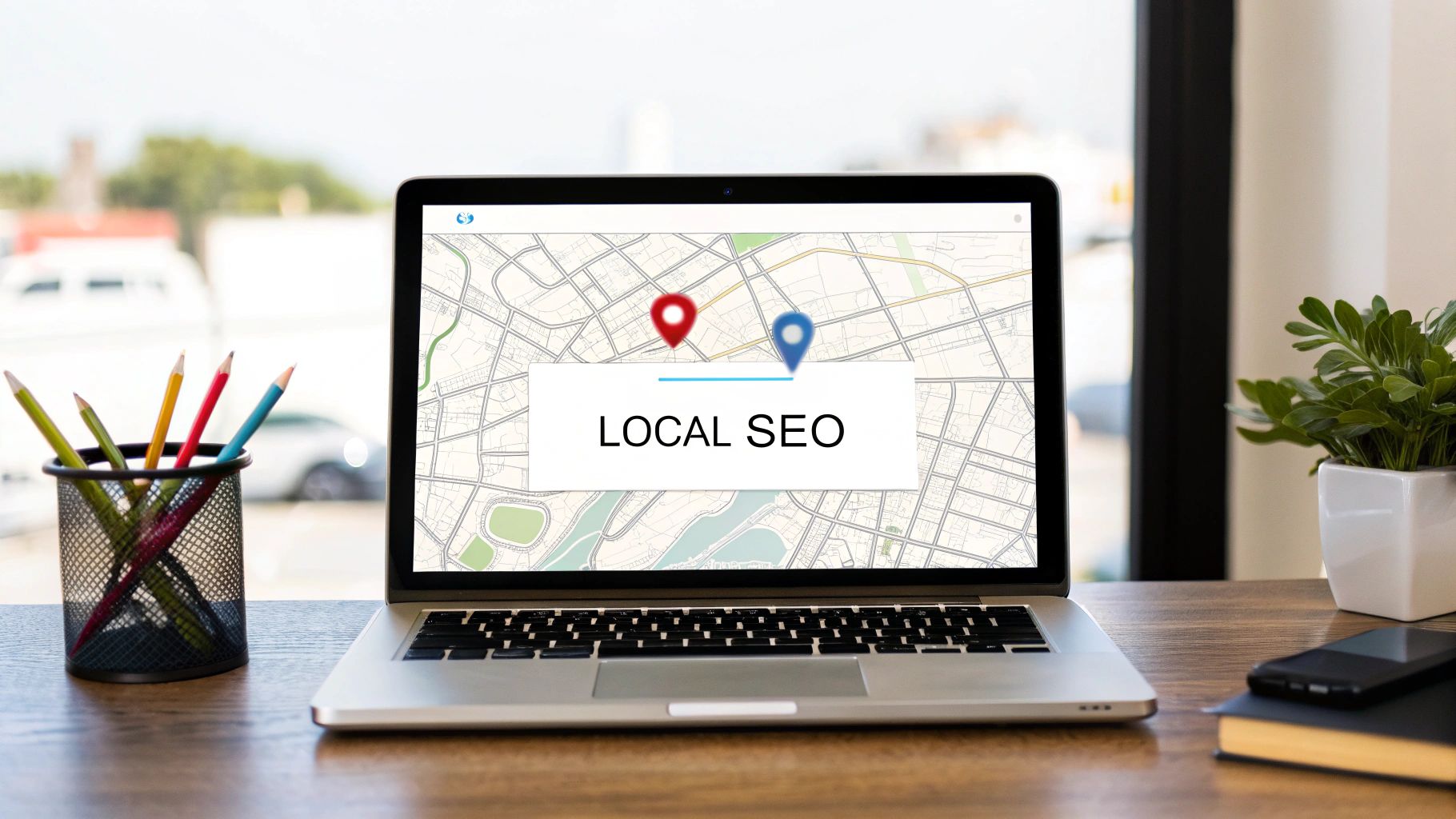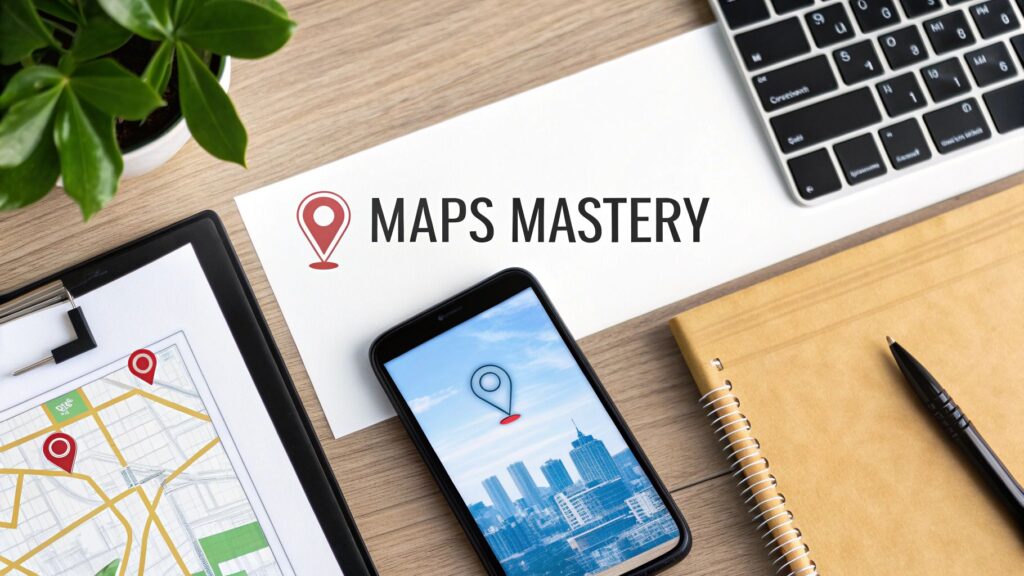Getting your business found on Google Maps isn't just luck. It's about optimizing your Google Business Profile (GBP). Think of your profile as your digital storefront—it needs to be complete, accurate, and engaging to turn a search into a customer.
In Short: A complete and active Google Business Profile is the #1 factor for ranking higher on Google Maps.
Why Ranking on Google Maps Matters
Ranking high on Google Maps is a huge part of local SEO. When someone searches for "best tacos near me" or "emergency plumber in Austin," the businesses in the "Local Pack" at the top get the calls. It’s not just about being the closest—it’s about convincing Google you're the best and most relevant option.
Your Google Business Profile is the central hub Google uses to understand who you are, what you do, and why you matter. A stellar profile is the single most important first step you can take.
A Complete Profile Is a Game-Changer
An incomplete profile is a red flag for Google. It suggests you might not be active or reliable, hurting your rankings. But a fully filled-out profile with accurate info, great photos, and regular updates shows you're an active, authoritative business.
The competition is real. The businesses that get their profile right see 70% more location requests and a 42% increase in clicks for directions. For small businesses, a 4-star rating or higher can lead to a 32% bump in foot traffic in just six months.
This diagram breaks down the core pillars for getting started.

It boils down to having a complete profile, compelling photos, and a steady flow of customer reviews. Understanding the full scope of local SEO benefits helps clarify why this effort is so crucial.
Everything you do to improve your profile—from adding new photos to responding to every review—builds your local authority. These actions create a better experience for the people looking for you, which is exactly what Google wants to reward.
Let’s get into the specifics of how to get this done.
How to Optimize Your Google Business Profile
Think of your Google Business Profile as your digital storefront. Just having your name and address isn't enough. To climb the ranks on Google Maps, you must turn your profile into a go-to resource.
It all starts with your Name, Address, and Phone number (NAP). This information must be identical everywhere it appears online. Consistency is key because it builds trust with Google, a massive ranking factor.
Beyond that, every field in your profile is an opportunity. An empty section is a missed chance to tell Google and your customers what you're all about.
Choose Your Categories Wisely
Your business category is one of the most powerful ranking levers. Google uses it to match you with relevant searches. If you get this wrong, you're invisible to the right people.
Your primary category needs to be the single best description of what you do. "Restaurant" is too broad. "Neapolitan Pizza Restaurant" is much better.
Don't stop at one. Add secondary categories for everything else you offer.
- A coffee shop? Add "Bakery" and "Sandwich Shop."
- A plumber? Add "Water Heater Repair Service" and "Drain Cleaning Service."
- A gym? Include "Yoga Studio" and "Personal Trainer."
These extra categories help you show up for specific, high-intent searches.
Craft a Compelling Business Description
You have 750 characters for your business description—make them count. This is your elevator pitch. It’s the perfect spot to show personality and include keywords about your services and neighborhood.
Tell a story. What makes you different?
For example, instead of "We are a plumbing company," try this:
"Your friendly, family-owned plumbing experts in North Austin. For over 15 years, we've been the go-to for 24/7 emergency leak repair, drain cleaning, and water heater installation. We're all about fair pricing and leaving every job spotless."
This version includes keywords ("plumbing experts," "leak repair," "North Austin") but also sounds human and trustworthy.
Pictures Tell the Whole Story
A profile without photos feels untrustworthy. High-quality photos are non-negotiable. Businesses with photos get 42% more requests for driving directions.
Show people what they're getting. Upload a mix of shots:
- Exterior Shots: Show your storefront so people can find you easily.
- Interior Shots: Give a feel for the atmosphere or your equipment.
- Product/Service Photos: If you sell a product, show it. If you provide a service, show the results.
- Team Photos: Let people see the friendly faces behind the business.
Pro Tip: Geotag your photos with your location data before uploading. It's another signal that tells Google you are where you say you are. Keep adding fresh pictures to show your business is active.
Get More Reviews and Engage with Customers
An optimized profile is great, but without engagement, it's just a digital brochure. Climbing the Google Maps rankings comes from social proof and community interaction. Reviews are a massive trust signal for both Google and your future customers.
Think about it: you're looking for a new pizza place. One has zero reviews. The other has 47 five-star ratings. Which one do you choose? Positive reviews tell Google that real people love your business. That's a powerful ranking signal.

How to Get More Google Reviews
Getting a steady stream of reviews is simpler than you think. It's about making it easy for happy customers to give feedback. The trick is to ask at the right moment—right after a great experience.
Here's a simple playbook:
- Get Your Direct Review Link. In your GBP dashboard, find the "Get more reviews" card. This gives you a short link that takes people straight to the review pop-up.
- Ask at the Point of Service. A small sign with a QR code at the checkout counter works well for retail. For service businesses, have your techs mention it after a job well done.
- Follow Up via Email or SMS. Send a quick, personal note after a project is done. A simple, "Thanks for your business! We’d be grateful if you could share your experience on Google," works great.
Of course, the best way to get good reviews is to provide an amazing experience. Check out these proven strategies to improve customer satisfaction to get started.
The Art of Responding to Every Review
Getting the review is only half the battle. Replying shows Google and potential customers that you are an active, caring business owner. Respond to all of them—good, bad, and neutral.
In Short: Responding to reviews shows you're listening and committed to a great experience, which boosts your reputation.
For positive reviews, a quick "Thank you so much! We're thrilled you enjoyed your visit and hope to see you again soon!" is perfect.
Negative reviews are an opportunity. Stay calm and professional. Acknowledge their complaint, apologize that their experience fell short, and offer to make things right offline. This shows everyone else that you take customer service seriously.
Use the Q&A Section
The "Questions & Answers" feature on your profile is an underrated tool. It lets anyone ask a question, and anyone can answer. You need to be the first one there.
Get ahead of the curve. Think about the common questions you get:
- "Do you have free parking?"
- "Are you dog-friendly?"
- "Do you offer vegan options?"
Go ahead and ask and answer these common questions yourself. This gives potential customers instant answers and gives you a natural spot to include important keywords.
Build Your Authority with Local SEO Signals
A great Google Business Profile is critical, but it's only one piece of the puzzle. To dominate the local map pack, Google needs to see you as a legitimate, respected business in your community.
Think of your GBP as your digital storefront. Other online mentions—directories, local blogs, industry sites—are like endorsements from your neighbors. The more consistent they are, the more Google trusts you.

The Power of Consistent Local Citations
One of the most important off-profile actions is building local citations. A citation is any online mention of your business's Name, Address, and Phone number (NAP).
These appear in many places:
- Big Data Aggregators: Sites that feed information to hundreds of other directories.
- Major Online Directories: Yelp, Bing Places, Apple Maps, Facebook.
- Niche & Industry Sites: Angi or Houzz for a plumber, TripAdvisor for a restaurant.
The golden rule is NAP consistency. Google cross-references your info across the web. If your GBP says "123 Main St." but Yelp says "123 Main Street," that small difference can create confusion and hurt your ranking.
🔑 Key Takeaway: Every citation needs to have the exact same Name, Address, and Phone number. This consistency is the foundation of local SEO.
Proximity and Citations Are a Winning Combo
Proximity is a huge ranking factor. Google wants to show users businesses that are close by. In fact, 86% of consumers use Google Maps to find local businesses.
When Google sees your exact NAP on multiple directories, it reinforces its confidence in your location. This makes it more likely to show your profile to searchers in your immediate area. Getting your citations right maximizes your relevance for your location.
Earn Local Links as Votes of Confidence
Getting backlinks from other local websites is a power move. A backlink is a clickable link from their site to yours. Think of it as a referral from another respected local source.
Where can you get these links?
- Sponsor a local little league team and ask for a link from their site.
- Get featured in a local blog or online news story.
- Partner with a complementary business for a cross-promotion that includes links.
These local links signal "geographic relevance" to Google. They prove your business is an active part of the community. This is a game-changer for service-based businesses, so it's worth digging into specific strategies around SEO for contractors to build local authority.
People Also Ask About Improving Google Maps Ranking
Here are a few common questions about local SEO.
How can I improve my local SEO ranking?
To improve your local SEO ranking, fully optimize your Google Business Profile, get a steady stream of positive reviews, build consistent citations across the web, and ensure your website has local keywords and schema markup.
Why is my business not showing up on Google Maps?
Your business might not show up on Google Maps if your profile is incomplete, unverified, suspended, or lacks relevance and prominence for the search query. It could also be too far from the searcher's location.
How do I get my business in the top 3 on Google Maps?
Getting into the top 3 (the "Local Pack") requires a strong focus on Google's main ranking factors: relevance, proximity, and prominence. This means having a perfectly optimized profile, a high quantity and quality of reviews, and strong local signals from citations and backlinks.
Connect Your Website to Your Local Success
Your Google Business Profile is powerful, but it doesn't operate alone. To dominate the local map pack, your website needs to send the same signals to Google. Think of your website and GBP as a team—together, they build authority and tell a consistent story.
This connection is what takes you from being on the map to being the top result. A well-tuned website acts as the home base for all your local SEO efforts.
Weave Local Keywords into Your Website
You have to speak Google's language. This means using geo-targeted keywords throughout your website to show you're a part of the community you serve.
Work these location-based terms into your main pages.
- Homepage: Instead of "Best Plumber," use "Best Plumber in the Denver Metro Area."
- About Us Page: Tell your local story, like "Proudly serving Highlands Ranch since 2005."
- Service Pages: Get specific. "Emergency AC Repair in Lakewood" is much more powerful than a generic description.
This confirms to Google that your business is relevant to people searching in those spots. For help finding the right terms, our guide on how to use Google's Keyword Planner is a great place to start.
Create Hyper-Focused Location and Service Pages
If you have multiple service areas or distinct services, create dedicated pages for each. These "city pages" are gold for capturing long-tail search traffic.
For example, a roofer in Chicago could create pages for:
- "Residential Roof Repair in Lincoln Park"
- "Commercial Flat Roofing in the Loop"
- "Gutter Installation in Evanston"
Each page needs unique content that speaks to that service in that neighborhood. This strategy signals to Google that you're an authority in specific locations.
Get Technical with LocalBusiness Schema Markup
LocalBusiness schema markup is a snippet of code you add to your website. It gives Google a perfectly organized cheat sheet about your business, translating your key info into a language search engines understand.
This structured data explicitly confirms your:
- Business Name
- Physical Address
- Phone Number
- Business Hours
- Service Area
Don't skip this. When you combine geo-targeted keywords with schema markup, you make it incredibly easy for Google's algorithm to understand your business.
Make Your Website a Local Hub
Finally, a few simple on-site tweaks can tie everything together. First, your website must be mobile-friendly. Over 60% of Google searches happen on mobile, and that number is even higher for local queries.
Next, embed a Google Map on your contact page. It's another clear signal confirming your physical location. Just be sure the address pin on the map is identical to the one on your Google Business Profile. Consistency is everything in local SEO.
Common Questions About Google Maps Ranking
Here are some of the most common questions business owners ask, with straightforward answers.

How long does it take to see results?
It depends. If your profile is new, simply filling it out and getting a few reviews can show a small bump in a couple of weeks.
But for most businesses, seeing real movement up the ranks is a marathon. Plan for 3 to 6 months of consistent effort. This means regularly getting new reviews, publishing Google Posts, and building your online presence. It's like building a reputation—it takes time.
What are the top 3 ranking factors for Google Maps?
Google’s algorithm is complex, but it boils down to three core pillars.
- Relevance: How well your profile matches a search. This is about choosing the right categories and using the right keywords in your descriptions and reviews.
- Distance/Proximity: How close you are to the person searching. You can't change your location, but you can be the most prominent result within your service area.
- Prominence: Your business's overall reputation online and off. Google looks at your number of reviews, average star rating, citation consistency, and website authority.
In Short: To win at Google Maps, be the most relevant, reputable, and authoritative choice for people in your area.
"My Google Business Profile was suspended!" What do I do?
First, take a deep breath. It's usually fixable. Don't panic and start making changes. Carefully read the official Google Business Profile guidelines to figure out what went wrong.
Most suspensions happen due to:
- Keyword Stuffing: Adding keywords or city names to your business name.
- Address Issues: Using a P.O. box or virtual office.
- Misleading Info: Incorrect hours or a forwarding URL.
Once you’ve found and fixed the problem, submit a reinstatement request. Be polite, explain what you fixed, and provide proof you're a legitimate business (like photos of your storefront).
Do I need a website to rank on Google Maps?
Technically, no. But it’s like trying to compete in a race with one leg. A website is a huge signal of prominence and authority to Google.
Your website is your central online hub. It's where you can detail your services, write blog posts, and establish yourself as an expert. More importantly, your website earns links from other local sites, which are powerful votes of confidence in Google's eyes. Without a website, you’re leaving a powerful ranking factor on the table.
Ready to stop guessing and start dominating the local map pack? The team at Clicks Geek specializes in turning your Google Business Profile into a customer acquisition machine. Let's build a strategy that drives real-world results. Find out more at https://clicksgeek.com.
Is Your Business Ranking in Google Maps?
Turn Google Maps into a Lead Engine w/ Clicks Geek’s AI-powered local SEO. 3,000+ clients served. Our proprietary, fully done-for-you Maps SEO system handles everything—keyword targeting, local optimization, content, reviews, and ranking strategy—automatically.






